A propeller feather servicing needs to be completed at least once a year. To do a full service the boat needs to be out of the water.
But before I get ahead of myself, what is propeller feathering, or in shorter terms what is prop feathering?
On a boat propeller the water resistance can be minimized by rotating the propeller blades until they are edgewise to the direction of sail.
This is called feathering propellers for sailboats. At this angle, the propeller does not rotate or rotates slowly; thus, its water resistance against the propeller on the boat is greatly reduced.
Have you seen the Max-Prop Automatic Feathering Propellers?
That is the propeller that we have. After motoring out of a bay and getting the sails up, we keep our throttle in tick over and then stop the engine.
Once we stop the engine while in forward the feather propeller automatically spins so that it becomes streamlined. It’s quite an innovative system.
Feathering propellers work for both monohulls and catamarans
Feathering propellers provide low drag, excellent reverse power, and efficient forward performance. Of course, that’s if you keep them maintained!
Watch the video and then check out the seven steps to servicing a feathering propeller (checklist) below.
7 Steps To A Propeller Feathering Servicing Video
Servicing Your Feathering Propeller Sailboat
- Wiggle the prop shaft. If there’s any movement in the shaft you may need to have your cutlass bearing replaced. The cutlass bearing is a rubber tube that holds the shaft in place.
- Replace the rope cutter spacers for new ones.
- Grease the inside of the propeller casing. Consider adding a nipple so you can grease the propeller feathering while under water.
- Check and replace anodes (propeller and prop shaft). To help make your anodes last longer, add just a small dab of antifoul paint inside the area where the anode is screwed onto the boat. The paint will prevent the anodes from disintegrating around the screw holes.
What else for feathering propellers?
- Make sure all the split pins on the cutter casing are intact, put through and bent backward.
- Sand the blades lightly to get any debris off.
- Paint the propeller with seven coats of egg whites. After each coat, let it dry and then apply the next coat. This works better for keeping the propeller clean than any high-cost offering on the market.
Servicing A Feathering Boat Propeller Images
Would you like more handy checklists for sailors?
Other how to videos & articles
- How to Service A Diesel Generator On A Sailboat
- Solar Power Installation On A Sailboat
- 20 Tips For Provisioning For A Long Sailing Trip
- How To Prevent Boat Engine Failure
Any questions or comments?
Please leave them below.
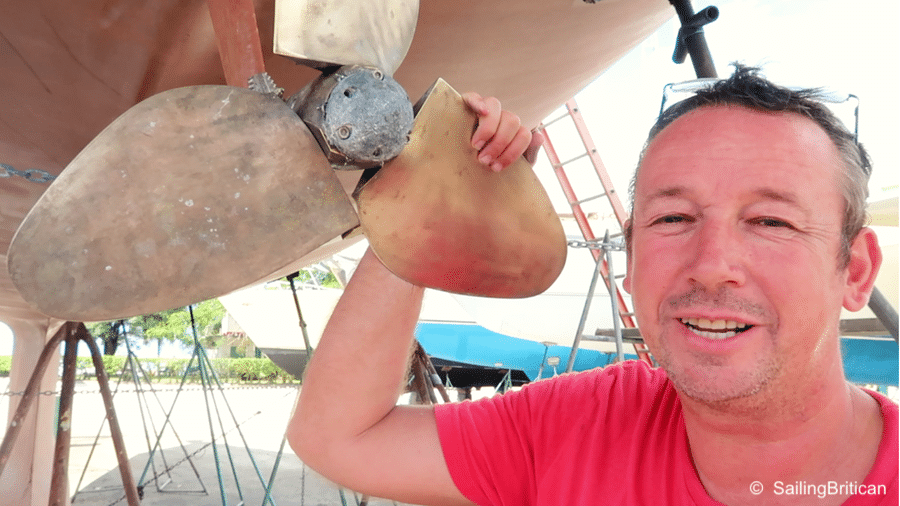
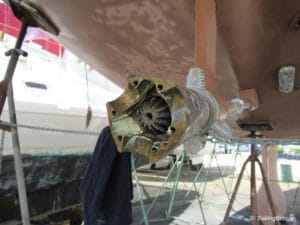
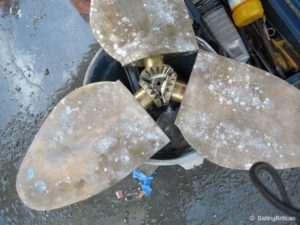
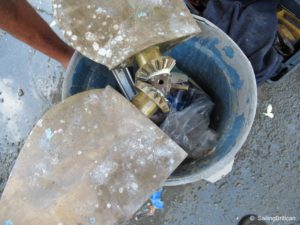
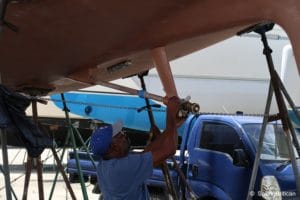
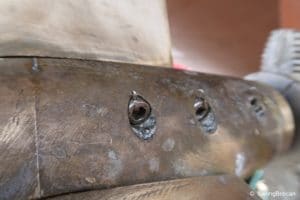


Nice video. I didn’t know Simon knows so much about the inner mechanics of the boat! He’s very skilled.
The sacrificial anode is there because different metals have different electric potential (very similar to the plus and minus of a typical battery, albeit at smaller values) and given enough time, and in the presence of the seawater, which conduces electricity, the conditions are there for a current to flow between those metals. This leads to metal erosion (it oxidizes). The sacrificial anode is chosen as such that its is the most electro-positive of them all (typically magnesium or zinc), and thus all the damage goes to it. Hence the word “sacrificial”. Every now and again, the anode can take no more electro-chemical reaction, its entire mass is consumed, and it has to be replaced. This, in turn, keeps the steel, bronze, aluminum, etc. onboard the ship safe for the entire time the anode is present.
Awesome explanation Serban. Thank you!